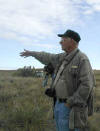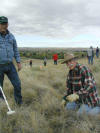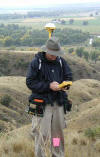| Friends Of The Little Bighorn Battlefield |
The Next Generation In The Study Of Custer's Last Stand |
Archeology Survey 2004 |
| • The Battle • Archeology • Memorials • Little Bighorn Store • News • Book Reviews |
All photos © Bob Reece unless otherwise noted Fall is a glorious time to visit the Custer Battlefield. The survey was originally to be conducted in May 2004; however, the funds did not become available until the fall. It's hard to believe, but it has already been 20 years since the first big archeological dig at the battlefield. Although this survey would not come close to matching that one in size, it did produce dramatic results.
Fall along the Little Bighorn River
The ProcessDouglas Scott handpicked his team of metal detectors. He was looking only for the best because he didn’t have time to spare, nor time to train. Scott also picked the “diggers”, those experts who could dig, find, and quickly identify an artifact; was it a bullet fired from a soldier’s weapon or an Indian weapon; was it an 1874 or 1877 cartridge buckle; was it a cartridge fired by Custer’s soldiers or by soldiers posted at Ft. Custer given the task of taking care of the Custer dead? Volunteers came from all corners of the globe. Mike Clark was as near as Billings, Montana while Derek Batten traveled from England. Derek, an experienced metal detector, has made all the digs since 1985. Douglas Scott - Chief Archeologist
Some of the Volunteers
The road survey was just that. We walked every inch of the battlefield road (both sides) 60 feet out from each side starting at the Reno Benteen Battlefield and ending at the grassy area in front of the visitor center patio. Scott’s team finished ahead of schedule by 10 A.M. Friday morning. When Scott dropped off the first wave of his volunteers at the Reno-Benteen parking lot the morning of September 13 they knew what to do. Flipping the switches of their detectors they lined up in perfect skirmish order, and with red pin flags secured in their belts they moved along side the parking lot sweeping their detectors back and forth.
Frontline metal detectors
When a detector set off a signal, the user placed a pin flag at that location and moved on. It was tempting for the frontline detectors not to stop at each signal and start digging. That wasn’t how the process worked. The only time I personally observed any members of the frontline digging was when they reached the end of their mark and were told to stop. They dug to save time and it was the only instance where they gave themselves the chance. This survey was conducted very professionally and with utmost discipline. I was very impressed.
Frontline placing pin flags
Trudging over the battlefield landscape with shovels and/or trowels in hand came the diggers. Paired with each was another metal detector. I rarely saw an instance where the digger dug and immediately found what the front liner tagged with the pin flag.
Following the frontline
The digger metal detector would hit the spot where the pin flag tagged the ground. Depending on the signal received, the detector would advise the digger to go deep (shovel) or shallow (trowel).
Digging at Greasy Grass Ridge, former Chief Historian and Superintendent Little Bighorn Battlefield Doug McChristian (L) and Conrad Angone (R)
Once the artifact was exposed it was left in the ground and coming up from behind was Carl Drexler, operator of the Trimble Pro XL GPS unit. Drexler is a PhD student at the University of Arkansas (but he’s a Texas man for sure and misses his home state). In the previous digs the NPS had to rely on the old form of surveying to pinpoint the artifacts location on a map. These days it has become much easier to do that. Carl would literally stand over the spot where the artifact was found, press a few buttons and there it was – the exact location of that spot on the entire globe. What magnificent technology!
Carl Drexler working the Trimble Pro XL
Standing beside Carl, during this process, was Anne Bond formerly of the Colorado Historical Society but now on her own as a consultant. Anne knows her stuff. She led the archeological project at Ft. Garland, Colorado. Anne was the master of the bag and the keeper of the artifacts. She gave each artifact a unique number before bagging it. Carl would note that same number, the item found, and its GPS location number in his book. Scott reviewed every item as it was found. You can read Scott’s field analysis on this site to learn what was found and the number of items. Webmaster's Note: You can now read Scott's final report. There were, of course, a lot of items found that were not battle related; pop tops, pop cans, automobile parts, and foil.
"Road to Weir Point"Evidence of Reno's Retreat From Weir PointBut, when something big was found, it created a lot of excitement. At the end of the first day near the boundary of the Reno-Benteen site, and on the NPS side, one area gave up 18 cartridges (45-55) fired by the Springfield carbines and U.S. soldiers. Everybody stood around watching the diggers retrieve items that I would venture to guess are evidence of Reno’s men retreating from Weir Point back to their defensive site. Whoever fought here gave one hell of a covering fire for their fellow soldiers. Found not far north of these cartridges were Springfield bullets and Henry spent cartridges. The Henry repeater was pretty much a favorite of the warriors that day and finding those cartridges might reveal the location where a warrior stood on the afternoon of June 25, 1876 firing at U.S. Army soldiers. Words are difficult to find that can express the way I felt when I observed relics such as these uncovered after 128 years.
Tuesday morning was cold, wet, and the ground muddy. It rained off and on during the night. Little Bighorn mud is like wet cement; it weighs you down, slows you down, it gets on your nerves. But, these volunteers didn’t let it get them down. They kept going and finding wonderful stuff. One big discovery was a beautiful arrowhead; it was long, narrow and it looked really deadly.
Superintendent Darrell Cook provided lunch for all the volunteers this day. I spent the afternoon working with Darrell so missed the action on the survey crew. Wednesday broke cool but sunny. We started at 8 a.m., as was done each morning and had our jackets off by 9 a.m. The morning found us moving down into Medicine Tail Coulee. There was more excitement in the air coming from the crew as we found ourselves entering Custer’s trail once again. Tourists were constantly stopping their cars and yelling out the windows, “Hey, what are you guys doing?” “Can I take your picture?” “Can I see what you’ve found?” One young woman from Wyoming acted as if she were at a Rolling Stone concert and got invited back stage. She was outside her car and running back and forth from each side of the road looking at what each digger found. We all got a kick out of her. Seriously, it was great to see total strangers show so much enthusiasm about what we were doing.
Custer's Cartridge?I am honored to report that I found probably the biggest find on Wednesday. It was a spent Remington 50/70 cartridge just on the south side of Greasy Grass Ridge and outside the boundary of the NPS. It was only a few feet from the road on the downhill side going toward Medicine Tail Ford. It was in pretty bad shape. Half of its casing was bent almost completely over the other half. Only a handful of officers, including Custer, fired weapons that would’ve used such ammunition. Could this have been a Custer cartridge? We’ll never know, but it was sure exciting to see the look on Doug Scott’s face when I showed it to him!
Little Big ManJust before we broke for lunch on Wednesday, we hit a spot in Medicine Tail Coulee on the east side of the road where the frontline had left dozens of pin flags. Soon I heard one digger ask Scott to identify the item found; it was a hairpin. Then, another digger found another hairpin and then again and again and again. What the heck were all these hairpins doing out here? Turns out we were in the middle of where the Last Stand was filmed for the movie “Little Big Man” starring Dustin Hoffman as Jack Crab. The hairpins were used to hold the American Indian wigs in place. Amongst the hairpins we also found a lot of Winchester blank cartridges, souvenirs from the same movie set.
At the close of business on Wednesday we were knocking on Custer’s door. We had reached the cattle guard on the battlefield road at the south entrance of the Little Bighorn Battlefield National Monument. We could see the white marble markers of the men from Company C, the trees in the Custer Battlefield National Cemetery, and the 7th Cavalry Monument on Last Stand Hill. Scott was proud of everyone’s work. We were a half day ahead of schedule. But, the weather forecast called for rain on Thursday. We were expecting Little Bighorn mud to accompany us again the following day. Custer Battlefield At LastThursday did start gray, cold, but not wet. We were finally inside the boundaries of the National Monument. Man, that was a great feeling. Now, I know why Scott started with Reno-Benteen first. The frontline started on the south side of the battlefield road working its way toward the markers of Company C. They immediately received hits and placed the red flags. The diggers followed behind, faithfully finding spent cartridges and bullets.
Frontline moving through Company C
Henryville, Jr.When we reached the first white marble markers we began to find artifacts that reminded us of the desperate battle that was fought on this land. Mike Clark found a 44 Colt unfired cartridge – the kind of ammunition an officer may have fired during the battle. Another very unusual find in the same vicinity was a metal point arrowhead – the kind the Indians acquired with trade goods. It was found at the base of one of the soldier markers. Across the road from this location, was a section of Greasy Grass Ridge (GGR). GGR was found to be a warrior position during the 1984 dig. Today, GGR gave up more evidence to support that – strewn all over the backside of the ridge were spent Henry repeating rifle cartridges. Found for the first time were several .44 caliber Sharps carbine cartridges. Two Moon surrendered weapons to Col. Nelson Miles a year later that could've fired such rounds. It's too early to know for sure, however, Douglas Scott has access to Two Moon's weapon as well as Iron Shirt's weapon that fired .44 caliber. Scott will test the firing pin imprint to reach a conclusion. Even more poignant were the finding of mushroom bullets. These were bullets that were smashed from impact; the cause of the mushroom effect could be from impact with human bone, or impact with a rock, a weapon, or any hard surface. But, when you hold one of these bullets you can't help but wonder if it wounded or killed one of the battle participants. The crew moved extremely fast this day even with more tourists stopping for the usual questions. We covered the entire east side of battle ridge and up to the Cheyenne markers along the west.
Friday was absolutely beautiful – clear blue skies. The project was completed by 10 A.M. Some of the items found were a Colt revolver backstrap, boot nails, and trouser buttons. Douglas Scott has an interesting job ahead of him. All 350 artifacts and the GPS information will accompany Scott back to Lincoln, Nebraska where he and his team will analyze the data. He will compare the data found in this survey with all the previous archeological projects at Little Bighorn Battlefield. He’ll perform ballistic tests, map the artifacts, and look for any new firearm types. Here at the Friends of the Little Bighorn Battlefield’s website we’ll provide you updates as soon as they are available. More PhotosBecome A Member Of The FriendsBack To Archeology Main Page |
|
|||||||||||||||||||||||||||||||||||||||||||||||||||||||||||||||||||||||||||||||||||||||||||||||
|
Copyright 1999-2013 Bob Reece Friends Little Bighorn Battlefield, P.O. Box 636, Crow Agency, MT 59022 | Home |
Board of Directors |
Guest Book | Contact | Site Map
| |
||||||||||||||||||||||||||||||||||||||||||||||||||||||||||||||||||||||||||||||||||||||||||||||||




































